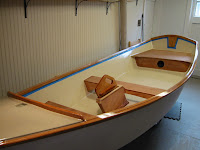
This is really getting exciting for me now! I have finished the construction of my CLC Jimmy Skiff ™. So, this past Monday, I took a vacation day off from work to finish the final coat of varnish, and to go to the NH Department of Motor Vehicles to register my little sailing vessel. In the state of NH, sailboats over 12' in length are required to be registered, but only need to display the stickers, and not the registration numbers as is required for motor boats. Since this is a new 'home-built' boat, the DMV issued a hull ID as well. I think I will have a small bronze plate engraved with the pertinent data, including the hull ID, and then attach it in a non-conspicuous location.
One thing that helped to keep me from rushing during the final stages is that I have been able to enjoy getting out on the water in my sea kayak. My son and I started our paddling season with an eight mile trip down the NH coast from New Castle headed south to Rye and back. It was a pretty windy day, and as much as I was having a good time, I couldn't help but think that it would be even better with a sail.
Next, I will get back to completing the sail. I still need to add the grommets, luff tape, boltrope, shackles and leech hem. In the meantime, here are some more pictures for your enjoyment...







































